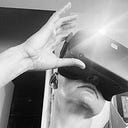Commonly Asked Questions About VR for Training
This page is meant to be a living document that will be updated as needed to answer common questions about using virtual and augmented reality for training. As it stands now, there is a disconnect between the core VR/AR industry and the mass audience that needs to buy in for it to be widely adopted. My hope is that this will serve as a resource both for those looking to have their questions about VR/AR for training answered and those who work in VR/AR and need easy talking points.
You can find out more about my agency, Friends With Holograms, on our website. And if you’re interested in working with us after reading this, please reach out!

How can I deploy VR content to a mass audience at my company? Don’t headsets cost a lot/take up a lot of space/require high powered computers or external phones.
Headsets have come down in price and gone up in quality a lot in the last two years. If you are deploying soft skills training at scale, the Oculus Go will change your life. It is $200, all-in-one (so no external phones needed, as was the case with the Samsung Gear), and fits easily in a purse (mine is with me constantly). An organization could buy twenty, for example, and they would fit easily in a drawer. If you want training where the user walks or moves around, the Oculus Quest was released in spring 2019 and is wireless, so no high powered computer is needed. It costs $400 and is bigger than the Go, but still portable.
Oculus has an enterprise platform which can be used to deploy the experience across devices, and we can help you integrate the content with an LMS as long as they have an API.
I heard VR makes people sick. What’s up with that?
Let’s make an analogy. Fish, for example, when not properly prepared, can make you sick, but the problem is with the preparation, not with fish. Ditto for VR. Bad VR experiences can absolutely make you lose your lunch — that’s why you need to engage with experts who understand spatial thinking and design to make sure your experiences don’t.

The person who originally posed this question worked at a company where non-VR people tried to make a VR experience. In the experience, the user had a person on either side of them and was forced to whip their head back and forth to follow in and oh my God I feel sick just thinking about it. But just as one poorly cooked piece of fish shouldn’t turn you off eating it forever, one bad VR experience shouldn’t turn you off the tech forever. Rather, you just need to be careful with who you let design experiences for you.
What is the difference between VR and AR?
Virtual and augmented reality often get lumped together, and while is some crossover, they are pretty different. To do well in both spaces, you need to understand how to think spatially and not just in 2D. However, AR is much more connected to the physical world and VR is far more immersive. There are strong use cases in training for both, but they are not interchangeable.
